By Sara Velander
After two and a half weeks of navigating our way across Paris whether it’s attending the circus of negotiations at the Le Bourget, taking frequent naps at our hostel at Gare du Nord, making banners at the art space in Jardin d’Alice or leading workshops at the Climate Action Zone, it is time for debrief. Once the negotiations ended and civil society demonstrations took place on December 12th the delegation (minus two) packed up their bags and left two days later to the small, nordic town of Uppsala, the location of our COP21 debrief session.
Here we were greeted with negative-degree weather, Swedish winter treats, and bright smiles from the Uppsala delegation that welcomed us on the night of December 14th. Our three-day debrief on the final Paris agreement and our experiences at COP21 hosted by Doreen Stabinsky and Uppsala University consists of a packed schedule of events, presentations, forums, and debrief sessions. Some of the expectations that will come out of this debrief is common way forward for civil society groups not just in Bar Harbor, Maine but also towns all over the world, like Uppsala, after the release of this new agreement that will supposedly make large-scale changes in today’s society. It is clear that there is a lot of work to do due to the lack legality, ambition and equity within the new agreement, the question is simply how and where to start.
The evening when the Earth in Brackets delegation arrived we coalesced at the Center for Environment and Development Studies (CEMUS) on the main Uppsala University campus. Here we learned about the daily schedule and housing logistics over tea, coffee and snacks (otherwise known as fika). The schedule looked something like this:
- Tuesday
- Brunch/debrief
- Tour of Uppsala
- Plan for CEMUS presentation
- Wednesday
- Finish planning CEMUS presentation
- Give CEMUS presentation @13:15
- Debrief session
- Thursday
- Brunch/conversation with UU delegation
- What Next Forum
- Gasque/Christmas Dinner
- Friday
- Finish coursework by midnight!
We started our first day in Uppsala with a brunch and short debrief session at Doreen’s apartment. Here we discussed general reflections of the new Paris agreement, our hi’s and lo’s from COP21 and how we should organize and structure the presentation we will be giving about the Paris Agreement at the Sustainability Winter Festival the next day. Following our brunch we were given a tour of some of Uppsala’s most prominent landmarks by one of the members from the Uppsala University delegation. Along with the former mayor of Uppsala, they showed us the famous Uppsala castle situated on top of a hill overlooking the city. Inside there was a gothic art gallery and a peace exhibit about Dag Hammarskjöld, one of the prominent UN architects. We were also shown around the Gustavianum, the former main building of Uppsala University now a museum known for its anatomical theatre, as well as the Uppsala Cathedral, one of the largest cathedrals in Scandinavia.
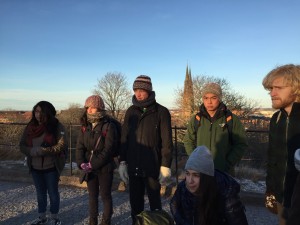
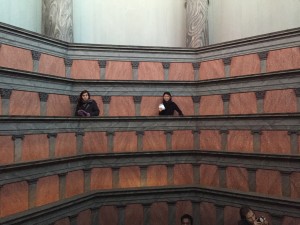
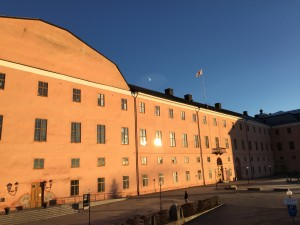
The rest of our day was spent planning for the presentation we were giving the next day titled “The Paris Agreement: What Next for Climate Change leadership? Report back from COP21.” This presentation is a part of the parallel sessions at the Sustainability Winter Festival that CEMUS organizes each year which is open to the general public. At the planning session we decided that the presentation would be composed of three parts: 1) Introduction of the delegations; 2) The Paris Agreement; and 3) Personal Reflections and What Next. The presentation was given by both Earth in Brackets members and Uppsala University students and complemented by a slideshow of pictures from our time in Paris.
On Thursday, December 17, the presentation opened with a performance by Angela and Augustin (also known as “Agua Libre”) of their renowned song, “Hombre de Papel.” This is a song that refers to the ineffectiveness of the UNFCCC and the false solutions like carbon markets that the UNFCCC avidly supports. The song wants to emphasize that it is at these spaces where important decisions are being taken and is therefore a call for people to mobilize.
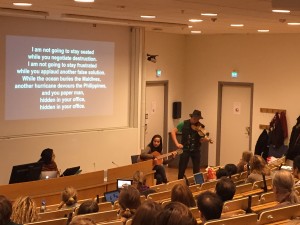
The song followed with brief introductions of the Uppsala and the Earth in Brackets delegations explaining what we did in Paris and what our general aims were in the inside and outside COP21 spaces. For the policy analysis, we stated clearly the key failures and successes (if any) of the Paris agreement. The statements made were directly based on a New Internationalist Article that parallels the Paris agreement with the People’s Test on Climate. We also highlighted three main fights that took place in the negotiating rooms including differentiation, ambition and finance. The policy perspective of the agreement was accompanied with a three-minute video of one of the empathic and empowering interventions Malaysia delivered during the closing plenary of the ADP.
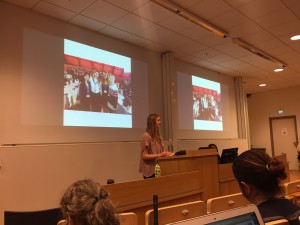
When providing reflections of COP21 we wanted to initially make it clear that there are two conflicting narratives that came out of Paris. One of them is how the media is portraying the agreement as a success and a reason to celebrate when the narrative that civil society is pushing is that the agreement should really be seen as a failure and a reason to work harder towards climate justice, making the movement stronger. One realizes at the COP that a lot of civil society knew that the Paris agreement was going to be a failure and therefore came to Paris to use COP21 as a convergence space for actions, alternative solutions, and mass demonstrations like D12 that aim to have the last word and make a bold statement on how this agreement is not the end.
What’s next is the need to push forward into 2016 with a strong movement that is ready to shut down fossil fuel projects and facilitate the transformation to a more sustainable and just world. A way that we can start is by supporting initiatives already established or taking form like the Leap Manifesto: A Call for a Canada Based on Caring for the Earth and One Another and Break Free 2016.
The discussion after the presentation centered around how corporations influenced the negotiations, the power of media on the Paris outcome, and legal issues with the USA ratifying the agreement in the next few months with the approaching 2016 elections.
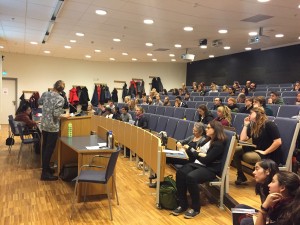
Thursday, December 17 will be our last day of our Uppsala debrief and our last full day for the Practicing Climate Politics course which has been 14 weeks delved into the UNFCCC and the Paris agreement. It will be emotional and energy-draining, yet will probably be one of our most important moments of the course. Our last day will focus on the fundamental topic of what’s next post-COP21, where we will participate in a three-hour forum along with several organizations around Uppsala that will be notable stakeholders for the transition movement here. This a conversation that will both be a page-turner and an instigator for organizations that have been dependent on the COP negotiations as a platform for action.
All in all, I hope that we all leave Uppsala on Friday, December 18, with a wealth of enriched knowledge on the Paris agreement, a set of tools of how to push forward the climate justice movement in 2016, and an established alliance between CEMUS and COA that will continue for years to come.
